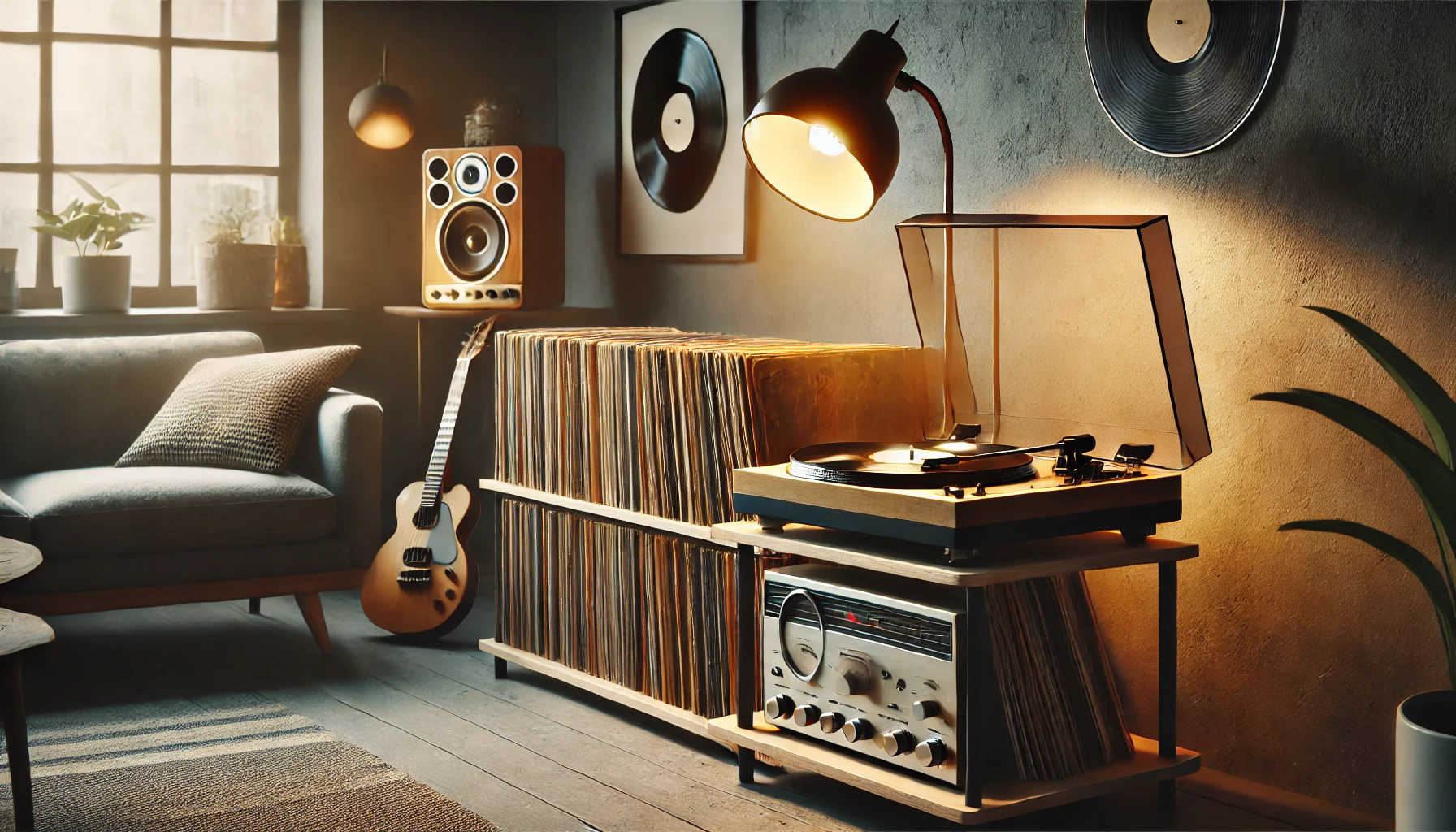Hey there, fellow vinyl enthusiasts! Let’s talk about something that’s been bugging me lately – the age-old question of whether it’s okay to leave our beloved records on the turntable.
I mean, we’ve all done it, right?
You finish spinning that perfect album, and you think, “I’ll just leave it there for next time.” But is that really a good idea?
I’ve been collecting vinyl for years now, and let me tell you, I’ve made my fair share of mistakes. There was this one time I left my prized first pressing of “Rumours” on the platter for weeks.
When I finally went to play it again, I was horrified to find it warped and covered in dust. That was a wake-up call, let me tell you!
So, I decided to dive deep into this topic, drawing from my own experiences and chatting with other vinyl aficionados.
In this article, we’re going to explore why leaving your records on the turntable might not be the best idea, and what you can do to keep your vinyl in tip-top shape.
Trust me, your future self (and your records) will thank you for taking the time to learn about proper vinyl care!
Is It Bad To Leave A Vinyl Record On The Turntable?
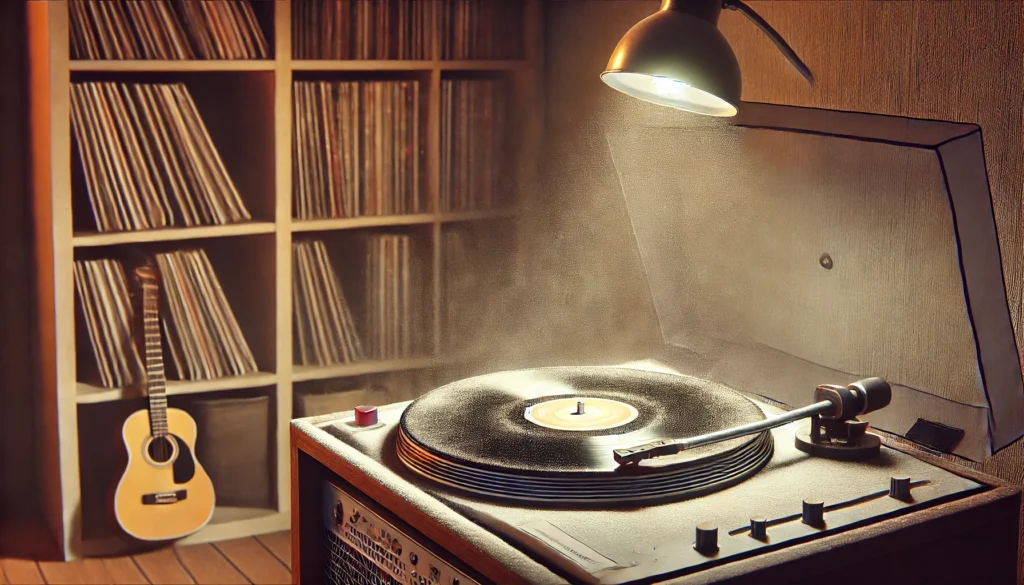
You bet it is! As a long-time vinyl enthusiast and collector, I’ve learned this lesson the hard way. Leaving a record on the turntable is like leaving your favorite book open and face-down on a dusty shelf – it’s just asking for trouble.
While it might seem convenient to keep that LP ready for your next listening session, doing so can lead to warping, dust accumulation, and even damage from constant stylus pressure. Trust me, I’ve ruined more than one prized record by being lazy about proper storage.
In this article, we’ll dive deep into why it’s a bad idea to leave your vinyl on the platter and explore better ways to care for your precious collection. But first, let’s get into the nitty-gritty of why this seemingly innocent habit can spell disaster for your records.
The Risks of Leaving Vinyl Records on Turntables
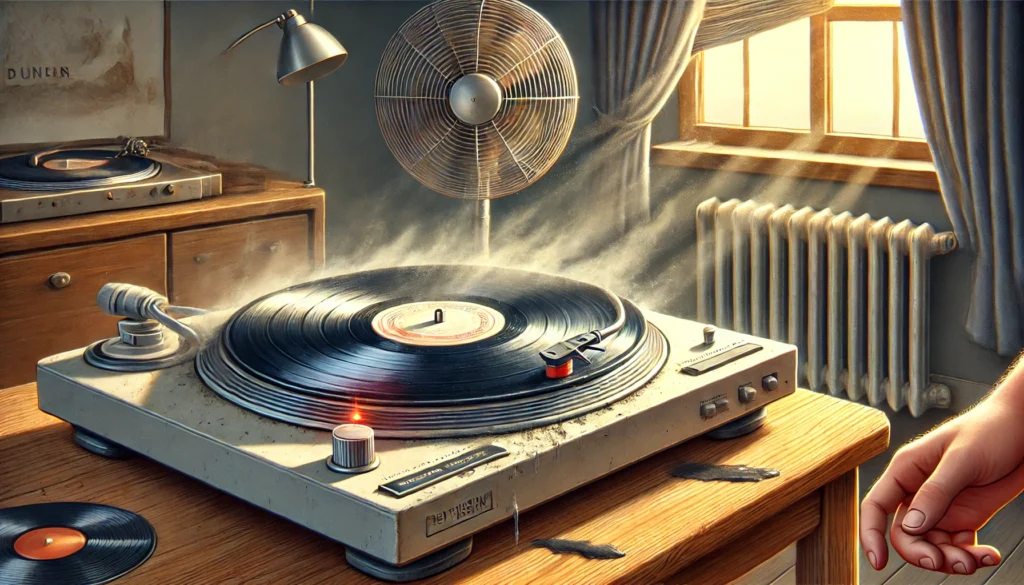
Oh boy, where do I even begin? Leaving your vinyl records on the turntable is like inviting a whole host of problems to your listening party.
Let me break it down for you based on my years of experience (and mistakes):
Dust accumulation: You wouldn’t believe how quickly dust can settle on an exposed record! I once left my favorite Beatles album on the platter for a week, and when I came back, it looked like it had aged 20 years.
Dust particles can work their way into the grooves, causing that annoying crackling sound we all hate. And let me tell you, getting that dust out is no picnic!
Warping: This is the big one, folks. I learned about warping the hard way when I left a limited edition pressing on my turntable during a heatwave.
The heat from the room caused the vinyl to warp, and now it sounds like I’m listening to music underwater. Vinyl is sensitive to temperature changes, and leaving it exposed on the platter can lead to uneven heating and cooling, resulting in that dreaded warp.
Stylus pressure damage: Here’s something I didn’t realize until I ruined a perfectly good copy of “Dark Side of the Moon” – constant pressure from the stylus can actually damage the grooves over time. Even if your tonearm is perfectly balanced, leaving it in contact with the record for extended periods can cause wear in that specific spot.
It’s like when you sleep in the same position all night and wake up with a crick in your neck – except your record doesn’t recover as easily.
Accidental scratches: I’ll admit it – I’m clumsy. And leaving records out on the turntable is just asking for trouble for someone like me.
Whether it’s a stray elbow while dusting or an overeager cat (yes, that happened), exposed records are vulnerable to all sorts of accidental damage. I once knocked a can of soda onto a record I’d left out, and let’s just say cola and vinyl don’t mix well.
The bottom line is, leaving your records on the turntable is a risky business. It might seem convenient at the moment, but trust me, the potential damage isn’t worth it.
I’ve learned to always return my records to their sleeves after playing, no matter how tired I am or how sure I am that I’ll play it again tomorrow. Your future self (and your records) will thank you!
Proper Vinyl Record Storage Techniques
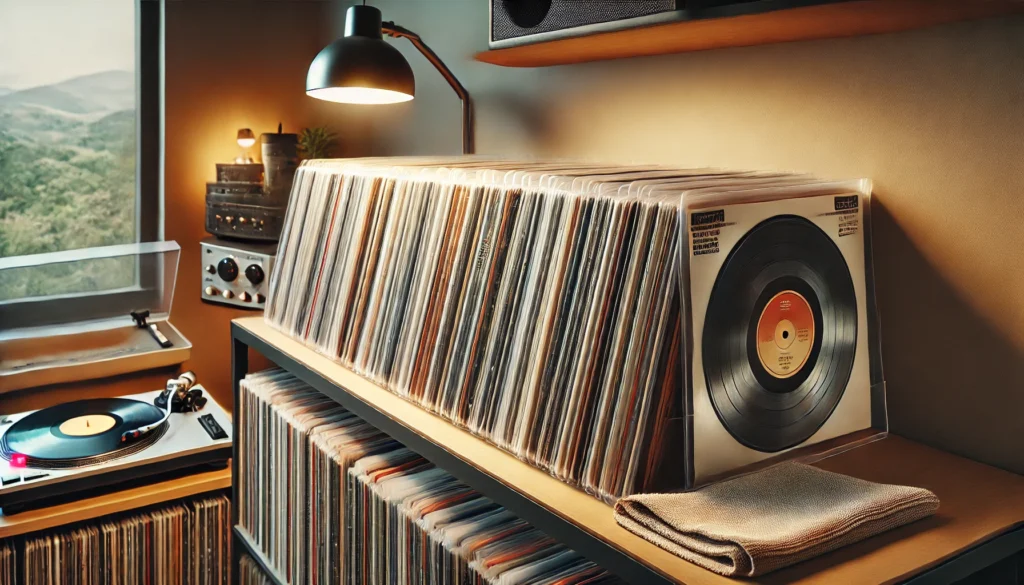
Alright, let’s talk about keeping those precious vinyl babies safe and sound! After years of trial and error (and a few tears shed over damaged records), I’ve got some tried-and-true techniques for you:
Vertical storage is your friend: I used to stack my records horizontally, thinking it was no big deal. Boy, was I wrong!
Stacking puts too much weight on the bottom records, leading to warping and groove damage. Now, I keep all my records standing upright, like books on a shelf.
It takes up more space, sure, but it’s worth it to keep my collection in top shape.
Clean sleeves are a must: This might sound obvious, but you’d be surprised how many people (including past me) neglect their sleeves. I make sure to use high-quality inner sleeves – those paper ones that come with the records are okay, but they can leave dust and paper residue on your vinyl.
I switched to poly-lined inner sleeves a few years back, and the difference is night and day. And don’t forget about the outer sleeves!
A good plastic outer sleeve protects against dust and minor spills.
Temperature and humidity control is crucial: I learned this lesson the hard way when I stored my records in a damp basement. The warping and mold were nightmarish!
Now, I keep my collection in a cool, dry place. Aim for a room temperature around 65-70°F (18-21°C) and humidity between 45-50%.
I invested in a small dehumidifier for my record room, and it’s been a game-changer.
Handling tips to live by: Okay, confession time – I used to grab records by the playing surface like I was palming a basketball. Cringe, I know!
Now, I handle them like they’re made of glass. Always hold records by the edges and the label area.
And for Pete’s sake, make sure your hands are clean! I keep a microfiber cloth nearby to wipe any fingerprints off the surface gently.
Regular cleaning is key: Even with proper storage, records can still accumulate dust over time. I’ve made it a habit to give each record a quick once-over with a carbon fiber brush before and after playing.
For deeper cleaning, I use a record cleaning solution and a microfiber cloth, but be careful – too much liquid can seep into the label or even the grooves.
Consider a record weight: This is a bit of an advanced tip, but using a record weight or clamp can help flatten slight warps and improve playback. Just be sure your turntable can handle the extra weight!
Remember, proper storage isn’t just about preserving your records – it’s about preserving the music and memories they hold. I’ve got albums that have been with me for decades, and they still sound fantastic because I’ve learned to take care of them properly.
Trust me, your future self will thank you for the effort you put into storage now!
Turntable Maintenance for Vinyl Longevity
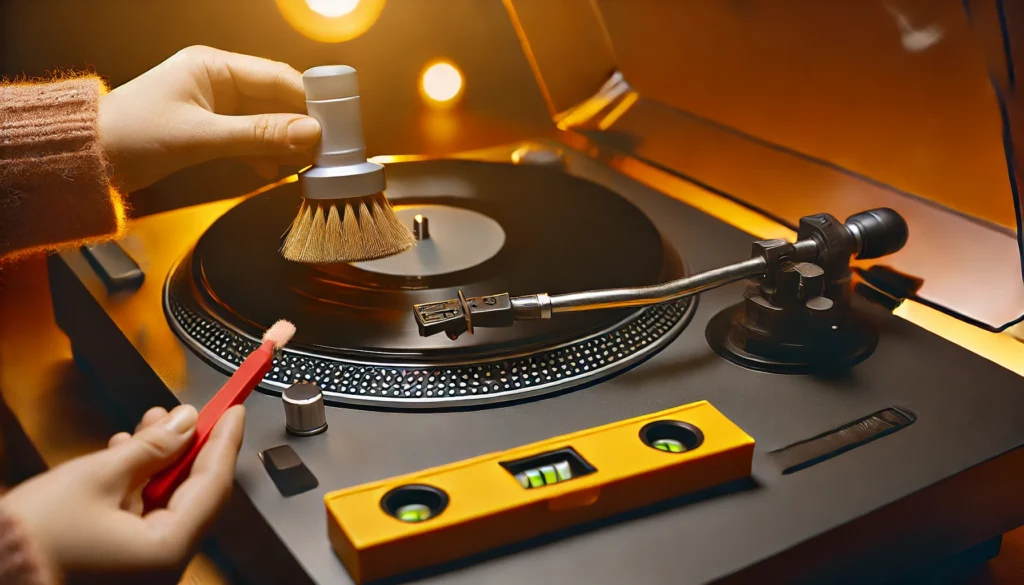
Let’s chat about keeping that turntable in tip-top shape! I’ve learned (sometimes the hard way) that a well-maintained turntable is just as important as properly stored records.
Here’s what I’ve picked up over the years:
Regular cleaning is non-negotiable: Dust is the enemy, folks! I make it a point to give my turntable a good once-over at least once a week.
I use a soft, anti-static brush to gently sweep away any dust from the platter, tonearm, and other surfaces. And don’t forget about the dust cover – keeping it clean helps prevent dust from settling on your records during playback.
Stylus care is crucial: Oh boy, did I learn this one the hard way! I once went way too long without cleaning my stylus, and the buildup of gunk was affecting my sound quality big time.
Now, I use a stylus brush (very gently!) after every few plays. For a deeper clean, I use a specialized stylus cleaning fluid about once a month.
Just remember – always brush from back to front, never side to side!
Calibration checks keep things humming: I used to think that once I set up my turntable, I was good to go forever. Wrong!
Over time, things can shift slightly out of whack. Now, I check my tonearm balance and tracking force every few months.
It’s a bit fiddly at first, but it makes a world of difference in sound quality and record wear.
Dust cover usage – a delicate balance: I used to always play records with the dust cover down, thinking I was protecting them. Turns out, this can actually cause issues with resonance and even increase static!
Now, I keep the cover up while playing (to reduce resonance) but always close it when I’m done to keep dust out.
Belt check for belt-drive turntables: If you’ve got a belt-drive turntable like I do, don’t forget to check the belt occasionally. They can stretch or wear out over time, affecting playback speed.
I replace mine every couple of years just to be safe.
Level playing field: I once noticed some weird playback issues and eventually realized my turntable wasn’t perfectly level! Now, I check the level every so often with a bubble level.
It’s a small thing, but it can make a big difference.
Keep it cool: I learned the hard way that electronics and heat don’t mix well. I make sure my turntable has plenty of ventilation and isn’t sitting in direct sunlight or near a heat source.
Cartridge alignment – the unsung hero: This is a bit advanced, but getting your cartridge properly aligned can significantly improve sound quality and reduce record wear. I use an alignment protractor every six months or so to make sure everything’s still in the sweet spot.
Remember, a little regular maintenance goes a long way in preserving both your turntable and your vinyl collection. I know it might seem like a lot, but once you get into the habit, it becomes second nature.
And trust me, when you drop the needle on a perfectly maintained system and hear that crystal-clear analog sound, you’ll know it’s all worth it!
Best Practices for Playing and Storing Vinyl Records

Alright, vinyl lovers, gather ’round! After years of fumbling my way through record collecting, I’ve finally nailed down some solid practices for playing and storing these precious platters.
Let me share my hard-earned wisdom with you:
Pre-play cleaning ritual: I always, always give my records a quick once-over with a carbon fiber brush before dropping the needle. It’s amazing how much dust can accumulate even in a clean sleeve!
This little habit has saved me from many a crackle and pop.
Post-play routine – don’t slack off!: I used to be guilty of leaving records out after playing, thinking I’d get back to them later. Big mistake!
Now, no matter how tired I am, I always return the record to its sleeve immediately after playing. Future me always appreciates it.
Storage rotation – keep ’em moving: I noticed that some of my less-played records were getting a bit… well, stuck in their ways. Now, I try to rotate my storage every few months.
It helps prevent warping from prolonged pressure in one spot.
Collection organization – find your groove: I used to have a chaotic “system” that only I understood. These days, I keep things alphabetical by artist, with a separate section for compilations and soundtracks.
Find what works for you, but trust me, some sort of system is a lifesaver when your collection grows!
Handle with care – every time: I cringe when I think about how I used to manhandle my records. Now, it’s edges and label area only, folks!
And clean hands are a must – I keep a microfiber cloth nearby for quick wipes.
Invest in quality inner sleeves: Those paper sleeves that come with records? They’re not doing you any favors. I switched to poly-lined inner sleeves a few years back, and it’s made a world of difference in keeping my records clean and static-free.
Outer sleeves for extra protection: I used to think outer sleeves were just for fancy collectors. Now, I use them for all my records.
They protect against dust, minor spills, and that annoying yellowing that can happen to album covers over time.
Temperature and humidity – be vigilant: I learned this one the hard way after storing some records in a damp basement. Now, I keep a hygrometer in my record room to monitor conditions.
Aim for around 65-70°F and 45-50% humidity.
Vertical storage is key: Stacking records horizontally is tempting when space is tight, but resist! Vertical storage prevents warping and keeps your records happy.
Regular deep cleaning sessions: Even with good habits, records can accumulate grime over time. I do a deeper clean with a proper record cleaning solution every few months, especially for my most-played albums.
Mind your tracking force: I used to think heavier tracking meant better sound. Wrong!
Too much force can damage your records over time. I check my tonearm’s tracking force regularly to keep it in the sweet spot.
Be mindful of static: Static electricity is the silent record killer. I use an anti-static gun before playing particularly troublesome records, and it’s like magic!
Know when to retire a record: This one’s tough, but sometimes you gotta know when to let go. If a record is severely damaged or worn, continuing to play it can damage your stylus.
I’ve had to retire a few beloved albums to “display only” status over the years.
Remember, these practices aren’t just about preserving the physical records – they’re about preserving the joy of listening to vinyl. There’s nothing quite like dropping the needle on a well-cared-for record and hearing it sound as good as the day you bought it.
Happy listening, folks!
Conclusion
Whew! We’ve covered a lot of ground, haven’t we? From the perils of leaving records on turntables to the nitty-gritty of proper storage and maintenance.
As we wrap up, I can’t help but reflect on my own journey with vinyl – the mistakes made, lessons learned, and the pure joy that comes from a well-cared-for record collection.
Remember, taking care of your vinyl isn’t just about preserving a physical object. It’s about preserving the music, the memories, and the unique experience that only vinyl can provide.
Each record in your collection is a little time capsule, holding not just music, but moments of your life.
I encourage you to take these tips and make them your own. Experiment with different cleaning methods, find a storage system that works for your space, and most importantly, keep enjoying your records!
The beauty of vinyl is in its tactile, involved nature – caring for your collection is part of the experience.
And hey, don’t be too hard on yourself if you make mistakes along the way. We all do!
I’ve certainly had my share of facepalm moments (like the time I tried to clean a record with dish soap… don’t ask). The important thing is to learn and keep improving your vinyl care game.
Lastly, I’d love to hear from you! What are your tried-and-true vinyl care tips?
Any horror stories or triumphs you’d like to share? Drop a comment below and let’s keep the conversation going.
After all, the vinyl community is all about sharing knowledge and experiences.
Now, if you’ll excuse me, I’ve got some records to listen to – properly stored and cared for, of course! Happy spinning, everyone!
